
Vol. 7, No. 3, March 2011 |
 Printer-Friendly PDF Version Printer-Friendly PDF Version |
2011 SART Planning Meeting
Building a Better Team
“Through SART, federal, state and local partners have joined forces to protect Florida’s agriculture and animal industries.”
Dr. Joan Dusky, Associate Dean for Extension, UF/IFAS
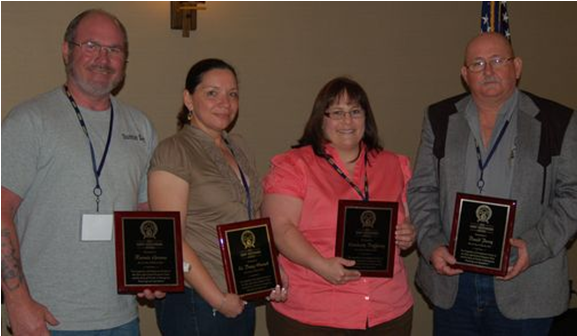 Left to right at the 2011 Florida SART Planning Meeting: Ronnie Graves, Daisy Harsch, Kim Duffiney and David Perry.
Left to right at the 2011 Florida SART Planning Meeting: Ronnie Graves, Daisy Harsch, Kim Duffiney and David Perry.
Four SART activists received plaques of appreciation during the Tuesday Awards Luncheon. They represent the four levels of SART’s multi-agency coordination effort. Florida ESF-17 coordinator Joe Kight recognized the four as “individuals who provide leadership beyond expectations seeking no recognition or reward other than personal satisfaction.”
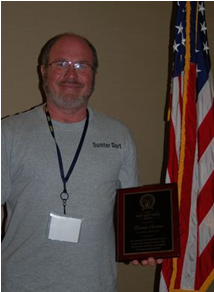 Ronnie Graves
Ronnie GravesPrivate or NGO Level
Ronnie Graves has built a national reputation by constructing and deploying equipment that takes care not only of animals during emergencies, but the people who rescue them as well. When Hurricane Katrina struck in 2005, Ronnie spent a month on the coast of Mississippi operating a compound for rescuers which served as a staging site for nightly transports to Hattiesburg.
Ronnie was involved in wildlife transport during the BP oil spill, and worked in three of the four affected states. He spent 2 ½ months in Louisiana. Today he handles many different transportation needs for animal rescue agencies across the U.S.
Based in Bushnell, Ronnie is the president of Sumter Disaster Animal Response Team, Inc. (DART) a 501 (c)3 not-for-profit corporation.
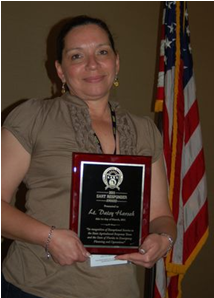 Daisy Harsch
Daisy HarschCounty Level
Daisy Harsch, a field services supervisor with Palm Beach County Animal Care and Control, manages the Commercial Licensing and Enforcement Unit. Daisy serves as Palm Beach disaster coordinator for animal related issues and as the Animal Services Unit Leader at the EOC during disaster activations.
Daisy also has oversight of the Palm Beach County pet friendly shelter which can house 600 animals and 300 people during hurricanes or other disasters. She has served in Palm Beach County since 2003 and is a member of several national committees working to resolve animal care issues.
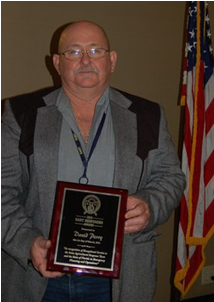 David Perry
David Perry State Level
David Perry has “been thee from the beginning.” Employed by FDACS/DAI since June 20, 1980 he has served the department and Florida SART as incident commander for eight hurricanes; has training responders in multiple courses; and has given numerous presentations about agricultural and animal issues. Today he represents Florida on several national committees and is SART co-chair.
With eight other team members, David deployed to Mississippi to assist with agricultural and animal issues following Hurricane Katrina’s disastrous landfall in 2005. He also led a Florida team to Texas in the aftermath of Hurricane Ike in 2008.
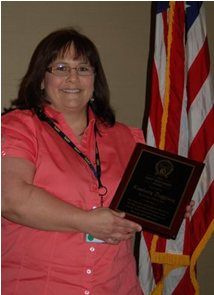 Kim Duffiney
Kim Duffiney Federal Level
Kim Duffiney has often stepped forward to promote the mission of SART and animal issues. She has a BS in Fisheries and Wildlife Management from Michigan State University and has worked on a variety of wildlife problems: migratory birds, whitetail deer (migration, density and mortality) and the spotted owl.
Kim is currently serving with USDA/APHIS/Animal Care where she is responsible for enforcing the Animal Welfare Act by conducting regular inspections of regulated facilities such as zoos, animal sanctuaries, breeders and brokers of regulated animals and animal exhibitors. She also represents Animal Care on the Florida SART Steering Committee.
Planning Meeting Evaluation
If you have not yet completed the 2011 Planning Meeting Evaluation, it is online at www.flsart.org/jsp/meetingevaluation/index.jsp. “Your response is anonymous,” says Michael Turner, SART Planner in FDACS’ Office of Agricultural Emergency Preparedness. “Your feedback will only be used to improve future meetings. “If you have additional questions, comments or concerns, contact me at (850) 245-1389 or michael.turner@freshfromflorida.com. And thanks for helping Florida Build a Better Team."
NOTE: Coming in the April issue of the SART Sentinel, “Planning Meeting in Review.” A session-by-session wrap-up of presentations, special ideas and take-home quotes – plus, your pictures!
If you had a favorite session or event at which you learned something new or if you met a responder with whom you would interface during an emergency or if the meeting helped you develop a more effective tactic or strategy to address a problem you are wrestling with, let us know. Just email the editors: Rick Sapp at rsa5@cox.net or Joe Kight at joe.kight@freshfromflorida.com.
[top]
NASAAEP Holds Third Annual Summit
A Symposium on Best Practices in Animal Emergency Management>
The National Alliance of State Animal & Agricultural Emergency Programs (NASAAEP) held its third annual Summit, December 6-9, in Las Vegas. The primary agenda items were best practices in animal emergency management.
Eight NASAAEP Best Practice Working Groups [and a ninth Zoological Best Practice Working Group], all sponsored by USDA APHIS’ Animal Care, briefed attendees about progress assembling best practice materials. These animal emergency management materials should be on-line in 2011.
The eight principal Working Groups are:
1. Animal Search and Rescue 5. Evacuation and Transportation
2. Animal Decontamination 6. Planning and Resource Management
3. Disaster Veterinary Care 7. Preparedness and Community Outreach
4. Emergency Animal Sheltering 8. Training
 Wayne Wingfield, MS, DVM
Wayne Wingfield, MS, DVMAnimal emergency management expert Dr. Wayne Wingfield opened the Summit by reviewing progress and highlighting work that’s still to be done. Dr. Wingfield is Professor and Chief of Emergency and Critical Care Medicine at Colorado State University, Department of Clinical Sciences, College of Veterinary Medicine Biomedical Sciences. (His book, The Veterinary ICU, is available in paperback).
Attendees then broke into three animal emergency management tracks:
- best practices,
- additional management issues and
- practical “boots-on-the-ground” issues.
Attendees also saw the “mini pet shelter” booth, an outreach tool developed collaboratively by NASAAEP, NARSC, AVMA, USDA and FEMA. This outreach targets state and local emergency managers, as well as veterinarians and other animal professionals who are not actively involved in animal emergency management. The booth shows how a co-located pet shelter would be set up and encourages discussion about how to incorporate pet sheltering in emergency operations plans.
For information about NASAAEP membership go to www.nasaaep.org. (This item was excerpted from www.aphis.usda.gov/anfs.
[top]
SART in Michigan
Michigan’s SART or MISART is a 501(c)3 nonprofit State Animal Response Team. Similar to Florida’s developing State Animal Response Coalition, it is an “interagency, coordinated effort dedicated to preparing, planning, responding and recovering during animal emergencies in Michigan. The mission is to develop and implement procedures and train and credential participants to facilitate a safe, environmentally sound and efficient response to animal emergencies on the local, county, state and federal level.”
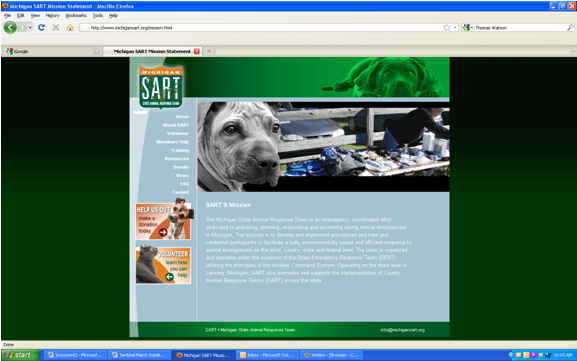
According to Nancy Barr and Mike Neault the team utilizes the principles of the Incident Command System and actively participates at the national level in the formation of NASAAEP. Formed in 2007, Michigan SART www.michigansart.org works with the Michigan Emergency Veterinary Network (Vet Net) and also promotes local CART organizations or County Animal Response Teams.
The web site’s home page features photos of Michigan veterinarians and volunteers responding to a 2010 toxic spill on the Kalamazoo River wherein hundreds of wild animals – muskrats, turtles, hawks, geese – were coated with oil. A few of their photos are posted (with permission) below:
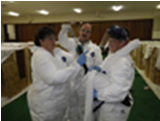 | 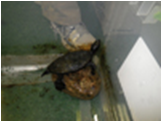 | 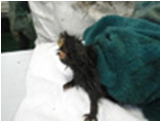 |
Veterinarians and members of the Michigan State Animal Response Team were present to help wild animals affected by an oil spill on the Kalamazoo River in 2010. They cleaned geese, turtles, several very feisty muskrats and assisted with the recovery of hawks. See additional photos at www.michigansart.org. | ||
About Michigan Vet Net
Formed in 2004 Vet Net is an education and training program for Michigan’s 3,600 veterinarians. The goal is effective response to animal disease-related emergencies. Vet Net is funded by USDA-APHIS, DHS and the Michigan State University College of Veterinary Medicine.
Vet Net has two components: general education for all vets and in-depth emergency preparedness training for those who volunteer to serve in the "corps.”
Vet Net is also sponsored by the Michigan Department of Agriculture (MDA), Michigan Veterinary Medical Association, Michigan Department of Community Health, MSU Extension and private veterinary practitioners.
For more information about Vet Net or the Michigan Veterinary Corps, contact the Michigan Dept. of Agriculture’s Animal Industry Division (517) 373-1077 www.michigan.gov/mda.
[top]
2011 Agroterrorism Preparedness Classes
FDACS’ Office of Agricultural Emergency Preparedness collaborates with several training partners to offer DHS-certified courses in Florida. All courses are open to all United States Citizens, and are free of charge through DHS grant funding.
Training partners include the Western Institute of Food Safety and Security at the University of California-Davis (WIFSS), the Center for Agriculture and Food Safety and Preparedness at the University of Tennessee-College of Veterinary Medicine, the University of Florida-Institute for Food and Agricultural Sciences and the Regional Domestic Security Task Forces.
WIFSS-PRESENTED COURSES
To register for one of the AWR courses or for more information: http://wifss.ucdavis.edu/agroterrorism/classes/classesbydate.php.
AWR-151
Understanding the Dangers of Agroterrorism
A ½-day introductory course on the topic of agroterrorism, aimed at raising awareness of the need to identify and defend against pathogens, chemical and biological contaminants, and other hazards that affect food safety. The course stresses the importance of responding to incidents of intentional contamination as well as natural disasters using the “all hazards” approach. This training has been approved for 3.5 CEUs for Certified Environmental Health Professionals.
Thursday, April 7
Winter Haven
Polk State College Learning Center WLR 104, 999 Ave. H NE, Winter Haven (Registration at 1:00 p.m. The workshop runs from 1:30 - 4:30.)
AWR-155
Principles of Frontline Response to Agroterrorism
and Food Systems’ Disasters
A 1-day course focusing on how an effective frontline emergency response can reduce or mitigate the effects of an agricultural emergency, an act of agroterrorism or other food system disaster. Frontline agricultural and public safety response teams, including personnel from the county, regional, state and federal agencies receive a comprehensive program formed around the principles of the Incident Command System (ICS) and the concept of Unified Command. This training has been approved for 5.0 CEUs for Certified Environmental Health Professionals.
Tuesday, March 15
Jacksonville
Regional Operations Center, 921 N Davis St. Building E
Wednesday, March 16
Gainesville
USDA Farm Service Agency, 4401 NW 25th Pl. Suite M
Wednesday, April 20
Miami
Regional Operations Center FDLE Bldg., 1030 NW 111th Ave.
Wednesday, May 11
Ft. Myers
Lee County Port Authority Training Facility, 15924 Air Cargo Lane
Thursday, May 12
Sarasota
Sarasota County Govt. Administration Center EOC, 6th Floor 1660 Ringling Blvd.
AWR-156
Principles of Planning and Implementing Recovery
A 1-day course focusing on the fundamental framework for orchestrating the recovery from an incident of agroterrorism. The course covers the four critical factors for success in a community recovery effort; identification of the components of a recovery plan targeted at minimizing the economic impact to the community and its citizens; and the identification of community resources and assets available for building partnerships. This training has been approved for 6.0 CEUs for Certified Environmental Health Professionals.
Tuesday, March 22
West Palm Beach
Division of Emergency Management, 20 South Military Tr.,
Wednesday, March 23
Ft. Lauderdale
Alvin Sherman Library, Research and IT Center, 3100 Ray Ferrero Jr. Blvd.
Thursday, April 21
Homestead
Miami-Dade Extension Office Agricultural Center, 18710 SW 288th St.
Wednesday, June 8
Seffner
Hillsborough County Extension Office, 5339 S County Road 579
Thursday, June 9
Sanford
Seminole County EOC, Dept. of Public Safety, 150 Bush Blvd.,
UNIVERSITY OF TENNESSEE-PRESENTED COURSES
To register for one of the MGT courses or for more information: http://flsart.org/mgtcourses/.
MGT 337
Agriculture & Food Vulnerability Assessment
(Utilizing the Carver + Shock method)
A 1 ½ day course (Day 1 from 8:00 a.m. to 5:00 p.m. with one hour for lunch and Day 2 from 8:00 a.m. to 1:00 p.m.) to assist food regulation, law enforcement and industry personnel in the prevention and deterrence of criminal acts that target the food industry. Registration through John Burkette, FDACS Office of Agricultural Emergency Preparedness: (850) 245-1387 John.Burkette@freshfromflorida.com or go to http://flsart.org/mgtcourses/ for information and links to online registration.
Tuesday-Wednesday, April 26-27
Miami: At the FDLE facility, 1030 NW 111th Ave.
Tuesday-Wednesday, May 10-11
Sanford: Seminole County Sheriff’s Office, 150 Bush Blvd.
MGT (Course # Not Assigned)
Sharing Information and Intelligence
Related to Food Importation and Transportation
A 1-day course (8:00 a.m. to 5:00 p.m. with one hour for lunch) to prepare participants to utilize and implement effective sharing of information and intelligence to enhance food safety and security related to food importation and transportation. It is targeted towards Law Enforcement, state Fusion Center personnel, emergency managers and responders, extension, public health, food and agriculture professionals, transportation industry and federal, state, local, tribal and regional officials. Registration through John Burkette, FDACS Office of Agricultural Emergency Preparedness: (850) 245-1387 John.Burkette@freshfromflorida.com or go to http://flsart.org/mgtcourses/ for information and links to online registration.
Thursday, May 26
Winter Haven
Polk State College, 999 Ave. 'H' NE, Student Center WST 126.
Tuesday, June 28
Jacksonville
At the FDLE facility, 921 N Davis Street, Bldg. E.
[top]
Lessons from the New Zealand Earthquake
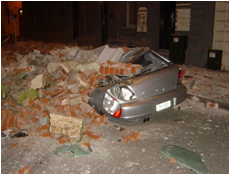


At the time this issue of the SART Sentinel went online, New Zealand was still trying to pick up the pieces from the 6.3-magnitude earthquake that devastated much of the city of Christchurch in February. Scores of people (and animals) are dead, hundreds trapped in the rubble and the emotional and economic damage is astonishing. (And this quake follows a 7.0 magnitude quake in a less-populated area in September 2010.)
According to David Cohen writing for the Christian Science Monitor (www.csmonitor.com) on February 23rd, emergency preparedness officials have long battled complacency in this nation of islands and hope this disaster will lead to a change in preparedness-thinking.
Cohen quotes structural engineer Graeme Beattie saying he is pleased with new building code legislation, but is dismayed about the “psychological preparedness” of the half-million area residents. Beattie noted how easy it was for the average citizen to become complacent, perhaps indifferent to a continual string of warnings and alerts which usually turn out to be false or only drills.
New Zealand has an official Earthquake Commission that handles financial claims in the aftermath of a seismic event.
[top]
Laurel Wilt Update
While wildfires rage up the dry Eastern coastline counties, laurel wilt disease has appeared in Miami-Dade. Carried by the redbay ambrosia beetle this disease may, within a few years, completely eliminate redbay, avocado and other laurels from Florida.
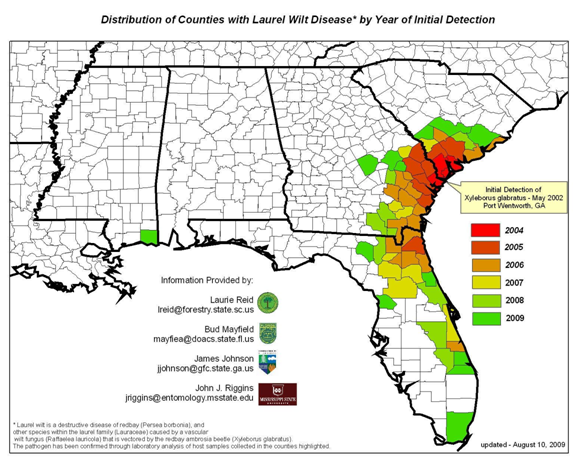
“Since the 2002 U.S. arrival of the beetle, and the disease in 2004,” writes Denise Feiber, FDACS-DPI Denise.Feiber@freshfromflorida.com, “laurel wilt has spread quickly throughout the southeastern U.S., destroying high numbers of bay trees. The disease has also infected a considerable number of residential avocado trees, primarily in North Florida.”
Avocados are a $13 million business in Florida with more than 6,773 production acres in Miami-Dade County, and some acreage in Collier County.
Dr. Wayne Dixon, FDACS/DPI Director, recommends:
1. Be familiar with signs of laurel wilt disease and the tiny redbay ambrosia beetle (http://www.doacs.state.fl.us/pi/enpp/pathology/laurel_wilt_disease.html).
2. Be alert for evidence of the pest/disease on trees.
3. Using local firewood only. Destructive pests and diseases, such as redbay ambrosia beetle and laurel wilt, hitchhike on infested firewood.
4. Don’t transport host trees (redbay, swamp bay, avocado, sassafras, pondspice, pondberry and others in the Lauraceae family) unless you purchase them from a registered nursery.
5. Use UF/IFAS- recommended methods for disposal http://edis.ifas.ufl.edu/hs391.
If you suspect trees are infected with laurel wilt or believe you have found a redbay ambrosia beetle, please contact FDACS’s Division of Plant Industry at (888) 397-1517.
To view management recommendations for homeowners, visit http://trec.ifas.ufl.edu/doc/homeowner-recs-RAB-LW-5-16-10.pdf.
If you would like to submit a plant or insect sample, visit http://www.doacs.state.fl.us/pi/enpp/pathology/laurel_wilt_disease.html for instructions.
For more information and to view a video on laurel wilt disease visit http://www.freshfromflorida.com/pi/enpp/pathology/laurel_wilt_disease.html.
[top]
Worthy of Note
1. Important Dates
April 6: Florida SART Advisory Board www.flsart.org meets at 10:00 am in the Board Room of the Florida Farm Bureau adjacent to Interstate 75 in Gainesville. Contact Joe Kight Joe.Kight@freshfromflorida.com or Michael Turner Michael.Turner@freshfromflorida.com.
May 15-20: The 2011 Governor’s Hurricane Conference www.flghc.org will be held at the Ft. Lauderdale-Broward County Convention Center.
May 23-26: Florida statewide Hurricane Exercise, Hurricane Griffin.
September 14: Florida SART Advisory Board www.flsart.org meets at 10:00 am in the Board Room of the Florida Farm Bureau adjacent to Interstate 75 in Gainesville.
For information on any of the above contact Joe Kight, FDACS/DAI, ESF-17 ECO (850) 410-0920 Joe.Kight@freshfromflorida.com.
2. Draft NIMS Training Plan
Liz Serca, assistant secretary for NASAAEP and Coordinator for Emergency Management for the Texas Department of Agriculture, lets us know that the NIMS Training Plan (formerly the Five-Year NIMS Training Plan) has been released for public review and comment. While the deadline for comments has passed, the 73-page January 2011 document is available online at http://www.regulations.gov/#!documentDetail;D=FEMA-2009-0012-0002.
Here are a few quotes. Why not see if you can find them in the document!
1. “A basic premise of NIMS is that all incidents begin and end locally.”
2. “Individuals who will be working in Multi-Agency Coordination including Emergency Operations Centers should take IS-700, ICS-100, IS-800, and other NIMS courses related to emergency management responsibilities.”
NOTE: IS-700 is National Incident Management System, An Introduction; IS-800 is National Response Framework, An Introduction; and ICS-100 is Introduction to the Incident Command System (ICS).
Liz also notes that a draft version of the FEMA NIMS ICS Emergency Responder Field Operating Guide (document number FEMA-2009-0014-0001) is available at regulations.gov for a public comment period. The Field Operating Guide was drafted to assist emergency response personnel in the use of the NIMS Incident Command System. The comment period closes on March 18th. Here is a link to the comment portal: http://www.regulations.gov/#!submitComment;D=FEMA-2009-0014-0001 Comments will be posted on the eRulemaking Portal.
Liz Serca can be contacted at office (512) 475-0402, cell (512) 680-9276 or Elizabeth.Serca@TexasAgriculture.gov.
 U.S. Fish and Wildlife Service Wildlife Forensics Laboratory, Ashland, Oregon.
U.S. Fish and Wildlife Service Wildlife Forensics Laboratory, Ashland, Oregon.3. Crime Lab
Laurel Neme’s book Animal Investigators: How the World’s First Wildlife Forensics Lab is Solving Crimes and Saving Endangered Species is available from the University Press of Florida (352) 392-1351 www.upf.com. The 256-page book is $19.95.
An environmental journalist, Neme (www.laurelneme.com) went behind the scenes in Ashland, Oregon at the only wildlife forensics crime lab in the world (www.lab.fws.gov/) to reveal how scientists and law enforcement agents of the U.S. Fish & Wildlife Service investigate wildlife crimes, protect endangered species and stem illegal wildlife trafficking. The Lab is designated the official crime lab of the Wildlife Working Group of INTERPOL (www.interpol.int) and CITES (www.cites.org).
4. Marion County Manual is online
Marion County’s Pet Friendly Shelter manual has been picked up and is presented online (as a PDF or Word document) by North Carolina’s Dept. of Agriculture & Consumer Services. You can read it at www.ncagr.gov/oep/Sheltering/resources.htm/.
Developed under the leadership of Jill Lancon, Animal Center Director (jill.lancon@marioncountyfl.org (352) 671-8709) the manual delineates its shelter purpose as: “Provide a safe haven for pet owners and their domestic pets in the event a disaster strikes Marion County and a Red Cross shelter is open for evacuees.”
Marion County’s document is quickly reviewable as a PDF. It is replete with photos and charts of the extraordinary 2004 season in which hurricanes Charley, Frances, Ivan and Jeanne crossed Florida.
Two very interesting pages are Acceptable Animals and Lessons Learned. If you review it you can answer the following questions:
- Is there a weight limit for dogs and if so, what is it?
- What type of reptiles will be accommodated?
- What entity paid for the shelter operation?
- How important were volunteers in the overall effort?
5. Niche Markets: The Changing Face of Agriculture – One Man’s Disaster is…
John and Cathie Gregory are retired school teachers. For 29 years they have owned Unicorn Hill Christmas Tree Farm (www.unicornhillfarm.com) in Alachua County where they raise 5,500 trees of multiple varieties on six of their 14-acres.
We wanted land, and wanted it to pay for itself,” John Gregory says. “We tried blueberries but that didn’t work for us. A University of Florida agronomist recommended Christmas trees.

A few years ago there were eight Christmas tree farms in Alachua County. Now there are only two, Unicorn Hill and BK Cedars. Several owners have retired and when young people see how much work is involved they don’t want anything to do with it. Plus, the price of land and taxes has skyrocketed.”
Nevertheless, in 2010 Gregory says he sold out his entire crop of trees in 11 days.
Michael Songer of Orange Park in Clay County is president of the Florida Christmas Tree Association www.flchristmastrees.com. He says there used to be more than 100 active Christmas tree farms in Florida and now there are about 30.
It isn’t only that young people can make more money with greater predictability and less effort elsewhere, but the cost of everything involved in cultivation – land and taxes, fuel and fertilizers – has increased dramatically while the ceiling for tree prices has only increased incrementally.
Songer says one problem – admittedly minor, even humorous if he weren’t paying for the trees – is a strong deer population. In the spring deer eat new growth and in the fall bucks rub their antlers against the trees to remove the velvet. Then, adding insult to injury, they thrash the tree as if they are prizefighters getting ready for a match. “This really tears up those trees.” Songer’s solution is to let them grow instead of cutting them down, hoping the deer will use the same trees year after year.
[top]
About the SART Sentinel |
The SART Sentinel is an e-mail newsletter prepared monthly by the members of the Florida State Agricultural Response Team. Past issues of the Sentinel are archived on the Florida SART Web Site www.flsart.org. If you have a story or photo that you would like to have considered for publication in the SART Sentinel, please contact the editors. Editor: Rick Sapp, PhD, Technical Writer, Florida Department of Agriculture & Consumer Services, Division of Animal Industry rsa5@cox.net Associate Editor: Joe Kight, State ESF-17 Coordinator, Florida Department of Agriculture & Consumer Services, Division of Animal Industry Joe.Kight@freshfromflorida.com [top] |
